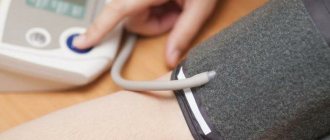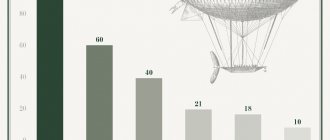Read in this article:
- Normal or pathological?
- What to do if the pressure on the right and left hands is different?
- Increase and decrease in pressure
- Reasons for the differences
- How to recognize blockage of blood vessels?
- How can the doctor help?
- How to avoid serious pathologies?
Everyone knows that blood pressure is measured on the arm. But if you put the blood pressure cuff on your left arm first and then on your right, the results may well be different.
What can affect and cause differences in performance?
There are several things that can cause differences in BP (blood pressure) readings. And not all of them are caused by diseases. The most common ones are discussed below.
Type of tonometer used
Devices for automatically measuring blood pressure are more convenient to use. The person simply needs to apply the cuff according to the instructions, press the start button and wait for the blood pressure readings to appear on the display.
But measurements are not always accurate, since if the cuff is applied incorrectly, the result will be distorted. The error may be 5–10 mmHg. Art. Mechanical blood pressure monitors are more accurate, but their use requires some skill.
Measurement time
The most accurate results can be obtained in the morning. Then - during the day - the body experiences various stresses, in particular, stress, physical activity, and eating, which can cause distortion of indicators.
To get the most accurate results, you need to measure blood pressure three times a day:
- in the morning immediately after waking up;
- until 14:00, but before lunch;
- just before bed.
If the indicators of each measurement on different hands are very different, then this is a reason to contact a therapist.
Violation of measurement rules
When measuring blood pressure, the person should sit straight, without leaning back in the chair. The hand should be positioned at the level of the heart so as not to provoke a false increase/decrease in readings. The cuff should not pinch your hand too much. Only by following all the recommendations can you obtain the most accurate blood pressure readings. The measurements can be repeated after waiting 10–15 minutes.
Important! The difference in pressure on the right and left hand is a natural condition. As a rule, blood pressure will be higher on the dominant arm. Permissible deviation – up to 10 mm Hg. Art. A figure of 10 or higher mm Hg is pathological. Art.
Fatigue and overwork
In a state of fatigue, blood pressure readings will be incorrect. If a serious difference is detected, a competent specialist will prescribe additional studies to identify the true cause of the pathology.
Normal or disease: how to find out?
If, when measuring blood pressure, you find differences between the results on your left and right arms, then analyze the facts indicated in the table.
| Factor | Impact factor |
| Magnitude of difference | A small range (up to 10 millimeters of mercury) is considered acceptable. The larger the range, the higher the likelihood of pathology |
| Increase or decrease in pressure | If the pressure on one arm is normal or increased, and on the other it is higher, then such a situation poses less of a danger than the pressure meeting the norm on one arm and decreasing on the other. |
| Age | More often there is a difference in pressure on the left and right hands in adolescents and older people |
| Left-handed or right-handed | The norm is an increase in pressure on the main working hand |
| Physical activity or sports | The difference may be a result of increased physical activity |
| Presence of complaints and unpleasant symptoms | If they are present, the pressure difference is a consequence of the disease |
For those who measure blood pressure very rarely, it is recommended to perform tonometry on both arms. Those who take measurements every day need to determine the left and right indicators at least monthly.
Possible reasons for the difference
There are three deviation options. This:
- On one hand the norm is normal, on the other there is an excess.
- On the left/right it is high, on the left/right it is even higher.
- On one hand - low, on the other - even lower.
The reasons why different hands have different blood pressure readings may be due to various factors. Most often this is:
Normal blood pressure during pregnancy
- Hypertonic disease. With this pathology, the patient experiences constantly elevated systolic (upper) pressure. Over time, the body “gets used” to this condition, but the heart pumps blood unevenly. As a result, this leads to differences in blood pressure in different arms.
- Stress. When under stress, the body releases adrenaline, norepinephrine and cortisol into the blood. In some cases, the inevitable increase in pressure occurs unevenly, which is reflected in the appearance of a difference.
- Anatomical features. For example, a person may have a different depth of the artery in their arms. In this case, the appearance of an error will be inevitable.
- Body features. Spasms of the muscles of the shoulder girdle or fibrotic changes occurring in the muscles may well provoke changes in blood pressure in the limb on the affected side.
- Vascular injury. Operations performed on blood vessels cause blood pressure disturbances.
- Increased density of the muscle tissue through which the subclavian artery passes.
- Arterial aneurysm. The condition requires urgent treatment, since its rupture can lead to death. If the aneurysm is located above the level of the cuff, then blood pressure readings on the affected limb will be lower than on the other.
- Thrombosis. The condition is very dangerous, since it can be complicated by the development of tissue ischemia against the background of poor blood supply and hidden necrosis.
- Formation of cholesterol plaque in the lumen of the subclavian artery (atherosclerosis). The pathology is accompanied by narrowing or complete blocking of the vessel. And this can also cause a significant difference in performance on different hands.
- Pregnancy.
The reasons for the difference in blood pressure are quite diverse, so you need to identify the specific one and take the necessary measures to eliminate it. Only in this case can we conclude whether this condition is normal or pathological.
What is the correct blood pressure if it is different on different hands? Doctors recommend focusing on a higher value and, to determine pressure, take measurements on the arm on which the tonometer determined a higher number.
Which indicator should be taken as true in case of different results?
According to protocols and recommendations for blood pressure control, if a difference is detected, it is necessary to:
- Continue measurements on the hand on which the readings are higher.
- Pause between studies for at least 2 minutes in order to completely restore blood flow.
- If there is a significant difference between the indicators of the first and second measurements, the third (if necessary, the fourth) is used.
- The final value is the average of the last three studies.
Dangerous symptoms
Various signs may indicate a pathological condition. The most common symptoms are:
- Weakness in the arm. A person cannot squeeze his hand tightly. As a rule, muscle weakness is noted on the side of the likely lesion.
- Poor circulation. The skin on the hand becomes bluish, and the limb itself becomes cold.
- Paresthesia. The condition consists of numbness of the fingertips and loss of sensation. This is a nonspecific sign of circulatory disorders. Paresthesia can also occur against the background of cervical osteochondrosis.
Important! Additionally, a person experiences symptoms typical of hyper- and hypotension.
There are a number of manifestations, the development of which the patient requires hospitalization. These include:
- causeless severe headache in the crown or back of the head;
- distortion of half the face or body is a symptom of a possible stroke;
- constant dizziness - can cause complete disorientation of a person in space;
- speech disorder;
- complete/partial paralysis;
- pain in the chest - when a heart attack develops, the pain is not severe, but constant, spreading to the epigastric region, causing difficulty breathing.
Emerging symptoms are assessed by a physician only as a whole. Depending on the severity of the manifestation, the patient may be hospitalized. The necessary assistance can be provided on the spot, but the person will be advised to visit a local pediatrician.
What can a significant difference between indicators indicate?
The pressure on the left and right hands should not differ too much. Permissible deviation – no higher than 10 mm Hg. Art. If the difference is more significant, then this is a sign of a disease. A difference of 10 units most often indicates atherosclerotic vascular damage.
If left untreated, a person may develop a stroke, myocardial infarction, or ischemic lesions. Basically, such a difference is diagnosed in people over 40 years of age, but sometimes it occurs earlier. A deviation of 15 units is a likely sign of acute heart failure, which in the future can lead to serious complications.
If a difference of 20 or more mm Hg is detected. Art. We can talk about complex violations. This is severe hypoxia of brain cells, complications of arterial hypertension, coronary heart disease, etc. A large difference in pressure between the right and left hand is accompanied by the development of characteristic symptoms. During this period, a person experiences:
- headache – sometimes very severe;
- attacks of nausea;
- dizziness;
- general weakness;
- breathing problems;
- coldness of hands and feet;
- darkening of the eyes.
The person becomes drowsy. There is a decrease in performance. It is possible that a feeling of tightness behind the sternum and a headache localized strictly in the occipital region may appear. If such symptoms often develop, it is necessary to consult a physician to identify the cause.
The difference in measurements on both hands does not exceed 10 mmHg. Art. is considered by doctors as an acceptable norm. But if blood pressure regularly deviates above this level, it is necessary to consult a specialist, since the cause of the condition may be heart and vascular diseases.
How to recognize blockage of blood vessels?
Blockage of blood vessels, which does not allow blood to circulate normally, may well manifest itself in a decrease in pressure in one arm. In such situations:
- The brush loses strength;
- The fingers become pale and cold;
- Numbness appears;
- Blueness of the skin appears on the fingers or the entire hand.
When the pressure on the right hand decreases and at the same time dizziness and headaches, vomiting and nausea, difficulty speaking and distortion of the face, weakening of attention and memory, paralysis of the body on one side appear, this indicates problems with blood circulation in the brain. The fact is that nutrients to the brain and right arm come through arteries that start from the aorta in the form of one trunk.
Differences in blood pressure readings during pregnancy
During pregnancy, different blood pressure readings in the arms can be determined at all stages, but most often they are typical for the last trimester.
Different blood pressure readings in the arms of pregnant women most often occur in the later stages
Quite often the cause is an inflammatory process that affects the arteries and causes a narrowing of their lumen. If left untreated, the pathology will progress. The tissues will not receive the necessary nutrients and the required amount of oxygen. The latter circumstance ultimately leads to the development of severe fetal hypoxia.
Differences in blood pressure in the lower extremities
To diagnose certain diseases, your doctor may also measure blood pressure in your legs. There is a difference in blood pressure levels in the arms and legs, but it is not too large. In this case, the indicators in the lower extremities - if the person is healthy - will be higher than in the upper extremities.
The permissible threshold is 20 mmHg. Art. If the difference is greater (regardless of which side the excess is noted), this means that the patient may develop a narrowing of the lumen of the aorta or main arteries. Low blood pressure becomes a sign of pathology.
The cause of deviation from the norm may be a common cold. The condition is accompanied by an increase in body temperature and a disturbance in general well-being. A slight excess of the permissible threshold may occur after cosmetic wraps for the purpose of weight correction.
What is a tonometer: which one is better for measuring blood pressure?
Tonometer
A tonometer is a special device for measuring blood pressure in a person. There are three types of tonometers:
- Mechanical
- Semi-automatic
- Automatic
In a mechanical tonometer, all the work is done by the person himself: he pumps in and releases air manually using a bulb, and determines the upper and lower pressure using a phonendoscope. In a semi-automatic tonometer, you also need to pump air using a bulb, but you no longer need to determine the pressure readings yourself; they will be displayed on the digital screen of the tonometer. Which device is better for measuring blood pressure?
- If you are planning to buy a tonometer to measure your own blood pressure, then you should abandon mechanical and semi-automatic tonometers. Their readings may be distorted because, according to the rules, you need to be motionless when measuring pressure.
- The best choice for measuring your own blood pressure is an automatic blood pressure monitor. All you have to do is put the cuff on correctly and press the button, after a while the indicators will be displayed on the digital display.
- If you want to purchase a tonometer to measure blood pressure for another person (not yourself), then you can choose absolutely any device that would fit all your requirements.
Below is some more useful information. Read on.
Diagnostic tests
To identify the cause of the pathological difference in blood pressure, you need to consult a cardiologist. If necessary, the doctor will refer the patient to see a specialized specialist: a neurologist or endocrinologist.
To make a preliminary diagnosis, the doctor will interview the patient and clarify what complaints he has. It is necessary to measure blood pressure levels in both arms to confirm the presence of a difference in indicators.
To clarify the preliminary diagnosis, the following studies are carried out:
- ECG is necessary to assess the functioning of the heart.
- Blood biochemistry and testing for specific hormones. Of diagnostic interest is the level of the hormones T3, T4, TSH, cortisol, as well as specific substances of the pituitary gland.
- Angiography. Rarely prescribed.
- Dopplerography. The study allows you to evaluate the speed of blood flow.
- General blood test.
If necessary, other types of studies may be prescribed.
Treatment
Before carrying out any treatment, it is necessary to make sure that the difference between blood pressure readings in the arms is pathological. To do this, you need to take measurements on both limbs over several days and record the indicators in a diary. When contacting a doctor, you must show the results obtained.
If the specialist “doesn’t like the numbers,” he will prescribe diagnostic tests. After completing the examination, the patient will be prescribed treatment, if necessary. This may include:
- drugs that improve the condition of blood vessels;
- agents for the treatment of atherosclerosis and dissolution of existing cholesterol plaques;
- medications that reduce blood density;
- drugs for the treatment of hypertension, alleviation of symptoms of vegetative-vascular dystonia.
It is mandatory to prescribe physiotherapy and undergo a complex of exercise therapy. Therapeutic gymnastics improves the function of blood vessels in the upper girdle. If necessary, the patient undergoes surgical treatment. The indication is the identification of large blood clots, tumor formations and sclerotic changes that have occurred.
When prescribing treatment, the doctor takes into account in which direction - increase or decrease - the change in blood pressure occurs. When it decreases, medications are used that stimulate the functioning of organs and systems.
Reviewing your personal diet will help normalize blood pressure
Additionally, a review of the diet will be recommended. You will need to exclude fatty, salty and smoked foods/dishes from the menu. Because they not only worsen the digestion process, but also negatively affect the condition of blood vessels.
Therapy methods
Treatment for pressure differences may include:
- taking medications that thin the blood and restore vascular patency, which helps improve blood circulation (the doctor selects medications in accordance with the disease that caused the problem);
- physical therapy that activates blood circulation;
- physiotherapeutic procedures.
If conservative treatment does not give the desired result, then the attending physician recommends surgery, during which blood clots and atherosclerotic plaques are removed, stents are installed on the vessels, or damaged arteries are replaced with prostheses.
If you contact a specialist in a timely manner, you will be able to not only find the cause of the problem, but also completely get rid of the disease.
Prevention
To prevent the occurrence of diseases and conditions that cause a high difference in blood pressure in both arms, you must follow the following medical recommendations:
- you need to move actively, do exercises, but try not to overload your muscles;
- eat a nutritious and varied diet;
- give up bad habits in favor of a healthy lifestyle;
- promptly treat any diseases of the cardiovascular system, including hypo- and hypertension;
- you need to regularly visit your doctor to monitor the dynamics of changes in the condition and monitor the effectiveness of the treatment;
- independently monitor blood pressure readings, taking measurements in the morning and evening - if regular deviations are detected, you should consult a cardiologist.
Differences in blood pressure readings on different arms are quite common and in most cases are an acceptable norm. But if the deviation “allowed” by doctors is regularly exceeded by 10 mm Hg. Art. You must consult a doctor.
Forecast
The prognosis in this case depends on the difference in readings in different hands. If the difference is large, the prognosis will be poor unless the person gets tested regularly and stays involved in treating the problem. The thing is that if the problem is related to a violation of the blood supply to the blood vessels of the brain, there is a high probability of both a stroke and a heart attack. These pathologies are often preceded by asymmetry of pressure in the hands. And more than half of them were fatal.
A favorable prognosis for pressure deviations if the difference in indicators is minimal. In this case, a person has nothing to fear as long as the difference is within normal limits.









